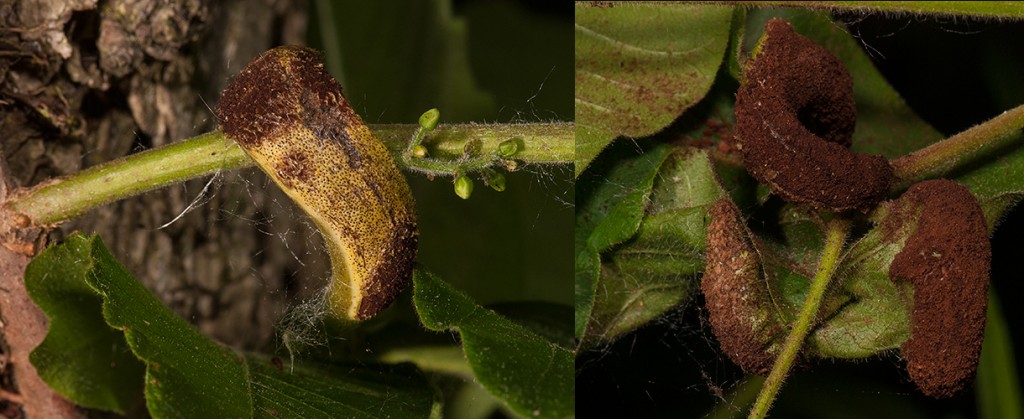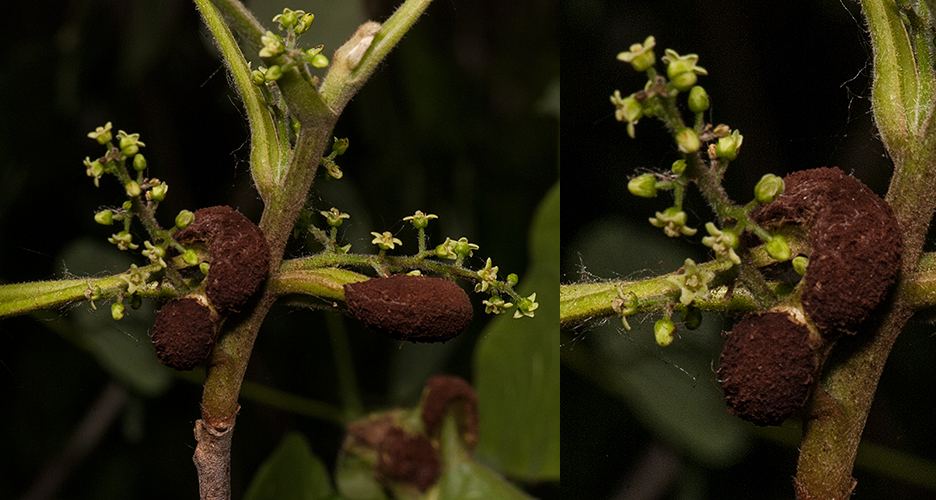When I found this growth on a poison ivy vine in Tenhave Woods, Royal Oak, Michigan, I did not know if it was an insect gall, a fungus growth, or a rust. Because it was growing on Poison Ivy (Toxicodendron radicans sensu stricto) , I did not closely examine it. I searched the internet for “rust Toxicodendron radicans,” “rust Rhus radicans,” and “galls” using both names with no luck. I studied the growths during the remainder of the summer and I was fairly certain that it was a rust.
I recently revisited the photos. Winter months are spent sorting and identifying photos. After searching the Internet for “rust poison ivy,” I found what looked like my poison ivy rust on Iowa State University’s Ada Herbarium website. It was under the name Pileolaria brevipes. This name lead me to an article by David Senchina titled “Fungal and animal associates of Toxicodendron spp. (Anacardiaceae) in North America” with photographs of my poison ivy rust.
Rusts are a small group of parasitic fungi consisting of approximately 7000 species worldwide. Somewhere around 175 species occur in Michigan. Rusts are so-named because their spores are often orange or reddish-brown. They can cause severe damage to important agricultural and timber crops.
Rust fungi have fascinating and complex lifecycles. They can have up to six different spore states during their lifecycle and may need two distinct host plants during their lifecycle (heteroecious) or a single species (autoecious). A rust species usually grows on a specific host species or group of species.
Here is a simplified Wheat Rust lifecycle. It is a heteroecious species with Wheat and Barberry serving as hosts. Wheat Rust over-winters in the soil as a thick-walled spore. They germinate in the spring and produce other spores of two strains (or sexes) that are carried by the wind to the upper surface of Barberry leaves. These grow and produce another type of spore that infects the lower surface of the leaf. From this growth, spores are produced that the wind carries to Wheat. When the rust grows on its Wheat host it produces spores that can directly infect other Wheat plants and then in the fall it produces the over-wintering spores. For a detailed life-cycle of the Wheat Rust and more information on rusts see the University of Hawaii’s Botany Department website.
Poison Ivy Rust’s lifecycle is simpler having just three spore types and a single host plant. It is widespread across most of North America.
There is no popular field guide for Michigan’s rust species. George Cummins and Yasuyuki Hiratsuka produced an Illustrated Genera of Rust Fungi allowing the identification of rust to genus using microscopic characters. My research for this blog has taught me that I see more rust species than I have previously noticed.
Copyright 2013 by Donald Drife
Webpage Michigan Nature Guy
Follow MichiganNatureGuy on Facebook



Interesting, concise and very informative.
Hi Nature Guy
I enjoyed your article on Pileolaria brevipes aka poison ivy rust
Here in Philadelphia pa I’ve noticed that this rust when it’s in the brown mustache phase will cause the petiole and petiolule to adopt a unusual and I think unwanted orientation of the poison ivy leaflet
That’s why I call it poison ivy navigator rust
Have you noticed a similar effect in Michigan?
I have seen two colonies of this rust in Michigan. One of them had the distorted leaves.
Pingback: What Are the Yellow Balls on the Jack Pine? | The Michigan Nature Guy’s Blog
I found the same thing here is Hudsonville Michigan. It still is not clear if ,underneath the rust, a gall is present or if the rust is forming on the natural shape of the vine/stem. A page at BugGuide seems to suggest that a gall midge may be at work and is causing a swelling/gall under the rust https://bugguide.net/node/view/1380462. Thanks for the very informative article, without it I don’t think I would have been able to identify this interesting natural phenomenon.
Note this link in your article is no longer valid
http://www.herbarium.iastate.edu/fungi/fungispecies.php?sp=Pileolaria+brevipes+Berk.+%26+Rav.
Thanks Gary. I have updated the link and it’s working now. Thanks for letting me know.